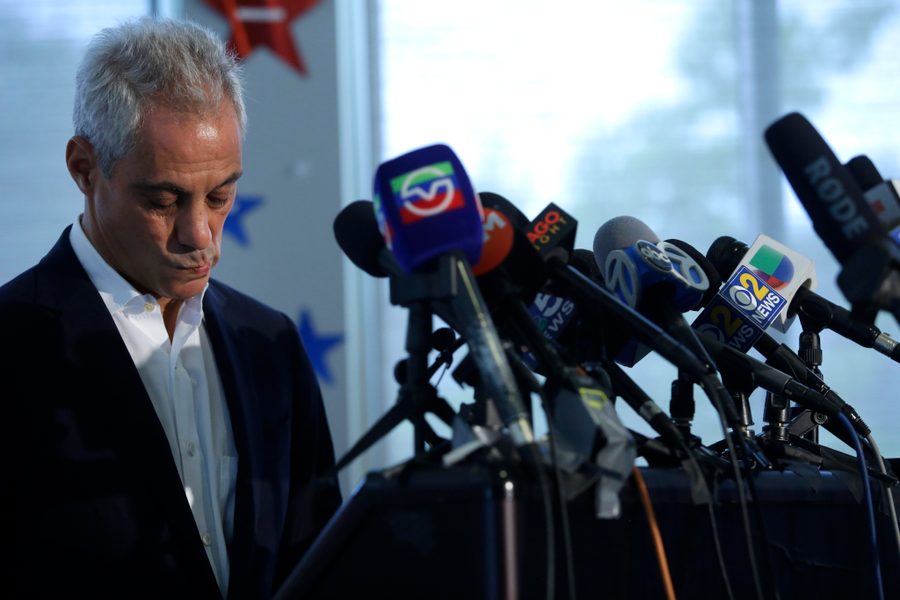Mayor 1% Rahm Emanuel Will Not Be Missed in Chicago
Emanuel will be remembered for his arrogance, impatience and disregard for regular Chicagoans.
Kari Lydersen

On July 7, more than a thousand Chicagoans marched onto the Dan Ryan Expressway on the city’s South Side, defying state police who threatened to arrest them.
Marchers were protesting issues including rampant gun violence on the city’s South and West sides. Mayor Rahm Emanuel publicly endorsed the action, locking horns with Gov. Bruce Rauner and state police over the planned civil disobedience.
But despite the mayor’s announced support, countless marchers named him as the target of their protest, and blamed him for the city’s violence.
Their main focus was not his policing strategy or position on gun laws, but rather his failure — or refusal — to invest in the South and West sides: African American and Latino neighborhoods ravaged by violence. While the national movement ignited by the teenagers from Parkland, Florida has focused largely on gun control, in Chicago, marchers on the expressway and countless other residents say devastating gun violence has caused by Emanuel’s actions over his tenure in City Hall: closing public schools, slashing city jobs, shuttering mental health clinics and investing in trendy neighborhoods while struggling ones languish.
Then there’s Emanuel’s most notorious controversy: Potentially covering up violence by police as highlighted in the shooting of Laquan McDonald.
Chicago’s gun violence and its pension crisis were the main issues highlighted in much of the national media coverage of Emanuel’s Sept. 4 announcement that he would not seek re-election in 2019.
While many Chicagoans clearly do blame Emanuel for the violence, and it would be a stain on any mayor, this framing lets Emanuel off the hook for the deeper reasons that so many city residents oppose him, especially African Americans and Latinos who live in the neighborhoods where violence is worst.
Even before Emanuel took office in 2011, he had already positioned himself as “Mayor 1%,” intent on reshaping Chicago as a glistening, hip global city that many felt had no room for regular people struggling to survive on low-paying jobs, with criminal records or in crumbling neighborhoods.
Emanuel promised to slash inefficiency and public spending, to run Chicago like a business and whip its finances into shape. And once in office, he followed through. But poor people with disabilities and mental health needs don’t make for a profitable business. And Emanuel has always seemed uninterested in — and even hostile to — the suggestion that serving them and listening to their demands is the mayor’s responsibility.
Likewise, labor unions and their members — which built America’s middle class and made Chicago the City of Big Shoulders — were an inconvenience and impediment to Emanuel, as he made clear from day one, picking fights with both trade unions and teachers who called out Emanuel’s role in a larger class war.
Inequality, segregation and gun violence have long been endemic to Chicago, and fatal shooting rates were higher in the 1990s than they are now, but that posed no threat to former Mayor Richard M. Daley’s power.
Many argue that Daley should have been held more accountable for his efforts to privatize and stratify the city. But in style if not in substance, Daley still respected the idea that working people, neighborhood organizations, labor unions and leaders of minority groups were players who had a seat at the table. Emanuel strode into office with the slick arrogance of the tech startup founders he adores, with no time for such aforementioned institutions or the scores of regular people they represent.
When he was called to task by the Chicago Teachers Union’s wildly popular 2012 strike, and when he was forced into a 2015 run-off by mayoral challenger Jesus “Chuy” Garcia, Emanuel responded with fits of pique and patronizing platitudes. Most saw through his attempts to throw money at black neighborhoods, glad-hand with black high school students or don a fuzzy sweater to apologize for being so abrasive.
An Emanuel comment last month about the gun violence seemed to signal that even these half-hearted attempts at engaging with and understanding regular people had become too wearing for the mayor. He essentially claimed parents and communities are responsible for stopping the violence by instilling better “values” and a “moral compass” in their kids. Many saw the comments aimed at low-income black and Latino parents, who are struggling just to get by in Rahm’s bifurcated Chicago.
In retrospect, it appeared to be a sign he was just done with it all, ready to move on to somewhere more appreciative of his talents, without having to risk the humiliation — or, perhaps in his view, just the hassle — of another election where multiple African-American candidates and his own former police chief are poised to spotlight all the ways he has betrayed and attacked Black, Latino and poor Chicagoans.
Or maybe Emanuel was just speaking from the heart when he made the “values” comment, one he reportedly had previously road-tested in private. If so, it points to the mayor being clueless about the complicated economic and social factors underlying gang violence and suggests he’s so unfamiliar with those neighborhoods that he hasn’t seen the ample examples of “good values” therein.
Either way, the comment was a fitting beginning of the end for Emanuel’s tenure in City Hall.
Depending what Emanuel does in the future, his time in Chicago may become a blip in an illustrious political biography. But in the Windy City, he will always be remembered by many as Mayor 1%, symbolizing the arrogance and impatience of those who would shape society to celebrate entitlement, fame and wealth. And his departure will be seen by many as a victory for those whose “values” encompass solidarity, empathy and democracy.
Kari Lydersen is a Chicago-based journalist, author and assistant professor at Northwestern University, where she leads the investigative specialization at the Medill School of Journalism, Media, Integrated Marketing Communications. Her books include Mayor 1%: Rahm Emanuel and the Rise of Chicago’s 99%.








